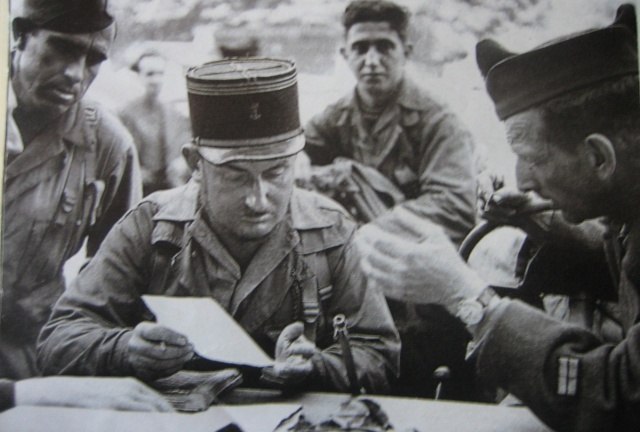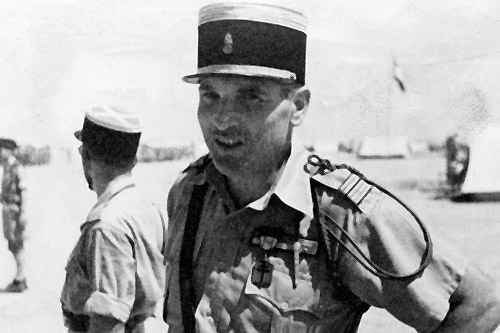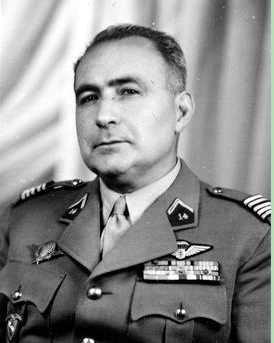<Back to Index>
- Captain of the French Army Raymond Dronne, 1908
- Lieutenant Colonel of the French Army Dimitri Zedguinidze - Amilakhvari, 1906
- General of the French Army Georges Roger Pierre Bergé, 1909
PAGE SPONSOR

Capitaine Raymond Dronne (Mayet (France) 8 March 1908 - Paris 5 September 1991), was a French civil servant and, following World War II, a politician. He was the first Allied officer to enter Paris as part of the liberation forces during World War II. He served as a volunteer ,who joined the Free French Forces in Africa in 1940. Later, he was assigned as commanding officer of the 9e Compagnie, du Régiment de Marche du Tchad (Ninth Company, Regiment of March of Chad), which became a unit of the French 2nd Armored Division.
During the move on Paris, due to combat conditions and poor road progress, General Philippe Leclerc, commanding general of the Second Armored, ordered Dronne to form an advance party, go to Paris and let the Resistance know that the Second Armored would be in Paris in 24 hours.
His advance party, the 9th Company, consisted of armored cars and Sherman tanks. In the French tradition the vehicles were named: the armored cars were called Guadalajara, Madrid and Ebro and the Sherman tanks were called Montmirail, Romilly and Champaubert.

Prince Dimitri Zedguinidze - Amilakhvari, more commonly known as Dimitri Amilakhvari (Georgian: დიმიტრი ამილახვარი, French: Dimitri Amilakvari) (October 31, 1906 - October 24, 1942) was a French military officer and Lieutenant Colonel of the French Foreign Legion, of Georgian origin, who played an influential role in the French Resistance against Nazi occupation in World War II, and became an iconic figure of the Free French Forces.
Amilakhvari was born in Bazorkino (now Chermen, North Ossetia – Alania, Russian Federation), where his family had moved from their ancestral estate at Gori, Georgia, during the Russian Revolution of 1905. The house of Zedguinidze - Amilakhvari had formerly served as hereditary Master of the Horse to the Georgian Crown (Amilakhvari) and retained their princely dignity during the Imperial Russian rule of Georgia. Dimitri's grandfather, Ivane Amilakhvari (1829 – 1905), was an eminent general in the Russian army. His father, Colonel Giorgi Zedguinidze - Amilakhvari, also served in the Russian military and transferred his loyalty to the short lived Democratic Republic of Georgia in 1918 - 21. After the Russian SFSR occupied Georgia early in 1921, the family fled to Istanbul, Turkey, where Dimitri attended a local British School, and later, in 1922, emigrated to France.
In 1924, Dimitri Amilakhvari entered the École Spéciale Militaire de Saint - Cyr and was commissioned as a second lieutenant after his graduation in 1926. At the same time, he was posted to the French Foreign Legion and promoted to lieutenant in 1926. He later served in French North Africa and took part in all important operations in the south of Morocco from 1932 to 1933. From 1934 to 1939, he was Head of the French military school in Agadir, being promoted to captain in 1937. Following his naturalization as a French citizen, he married another member of the exiled Georgian nobility, Princess Irina, née Dadiani (1904 – 1944) in August 1927. Note that during his French service, the spelling of his surname was modified, dropping the 'h'.
During the "Phoney War" before the German occupation of France, Amilakhvari was serving in Algiers in North Africa, but in the spring of 1940 he joined the French expeditionary force earmarked for the Norwegian campaign. He fought at Narvik and was then evacuated to the United Kingdom, where he joined the Free French Forces. He then took part in the unhappy campaigns against the Vichy French forces in West Africa, at Dakar (in Senegal), and Equatorial Africa, in Cameroon. In a remarkable record of service, his war service in 1940 had thus taken him from Africa to the Arctic Circle and back again, as far as the Equator, all in the space of a few months.
Amilakhvari's next move took him half way round the continent to Eritrea, in East Africa, to join the East African Campaign against Italy, in early 1941, but by the summer he was on the move again, to take part in another campaign against Vichy France (with units of the French Foreign Legion serving on both sides of the conflict), in Syria. This would be the closest he would come to the land of his birth.
In 1942, Amilakhvari was back in North Africa, facing the German and Italian forces in Libya as part of the North African Campaign. During the hard fighting at the Bir - Hakeim (January) he wrote: "We, foreigners, have only one way to prove to France our gratitude: to be killed ...". Nevertheless he survived, and in June he was made a Companion of the Liberation, a decoration second only to the Légion d'honneur. In 1942 he was also awarded the Krigskorset med Sverd or Norwegian War Cross with Sword for his earlier service in Norway. This is Norway's highest military decoration for gallantry and he was one of only 66 Frenchmen awarded this decoration during the Second World War.
In October 1942, the Allies began the final offensive in North Africa with the Second Battle of El Alamein. This battle took the Allied forces right across Libya and into French North Africa, where Amilakhvari had begun his operational service. However, Amilakhvari did not live to complete his great African odyssey, as he was killed in action on the second day of the battle.
In 1955 Amilakhvari was posthumously awarded a Chevalier of the Legion of Honour (Légion d'honneur). General Charles de Gaulle named him and his legionaries the "honor of France" for their heroic defense of the Allies' positions.

Georges Roger Pierre Bergé (3 January 1909 – 15 September 1997) was a French Army general who served during World War II. He enlisted in the Free French Forces, where he took command of the 1re compagnie de chasseurs parachutistes (1st Parachute Chaser Company). He is mentioned by David Stirling as one of the co-founders of the Special Air Service (SAS). In Great Britain and Egypt, he organized the training for Allied agents sent to France and led the first airborne mission in occupied France, named Operation Savannah. He fought in Syria and Crete. After his capture by the Germans he was imprisoned in Colditz Castle.
Georges Bergé was born on January 1909 in Belmont, in the Gers département, France. He was drafted in 1929, and incorporated in the 24th infantry regiment in Mont - de - Marsan, where he was trained as a reserve officer. In April 1930, he was demobilized as a second lieutenant. In 1933, he eventually chose a military career and attended the école de l'Infanterie et des Chars (Infantry and tanks school) in Saint - Maixent. He was made a lieutenant in 1934.
1940
- May. He fought at the front line. On 18th, while leading a successful counter attack near Bousies in the North, he was wounded twice and transported to Arras. After hospitalization in Caen, he was evacuated further south.
- June.
- 17th. While visiting his parents in Mimizan, Landes, he heard marshal Pétain's radio address.
- 21st. Refusing the armistice, Georges Bergé embarked on a polish boat in Saint - Jean - de - Luz and sailed for England.
- 24th. Joining the Free French forces in London, he met general Charles de Gaulle at Saint Stephen's House and suggested to him to form an airborne battalion.
- He integrated the air force staff of the Free French forces.
- September. The 1re Compagnie d'Infanterie de l'Air or 1re CIA (1st Airborne Infantry regiment) was formed with Bergé as its commanding officer.
- He was trained in Ringway school (Manchester).
- December. Bergé and his men were now paratroopers.
1941
- March.
- 15th. He was parachuted in France as leader of the first Free French mission in occupied France, Operation Savannah, planned by the SOE.
- 22nd. He joined Mimizan and contacted friends to form a resistance network.
- April. On the 5th, he came back to England by submarine. Mission Savannah was over.
- Under the supervision of the Deuxième Bureau (then the Bureau Central de Renseignements et d'Action, the Free French external military intelligence agency) and the SOE, he established a special agents school - 36th station of the SOE, Inchmery House, New Forest - where most of the agents sent in France in 1941 and 1942 were trained.
- July. On the 25th, with the 1re CIA, he was allocated in Damascus (Meze airfield)
1942
- January. Allocated in Kabret in the Combined Training Center, west bank of the Suez Canal, he formed the French SAS squadron. As the SAS expanded, the French squadron would be the first of a range of units to be 'acquired' by David Stirling.
- June. His unit was tasked to attack enemy airfields in the
mediterranean zone. Bergé chose Heraklion airfield, Crete. With a group
of four men, he managed to destroy 20 enemy planes.
19th. He was captured at the conclusion of his mission. He was imprisoned in XC Oflag in Lübeck, from which he tried to escape in vain.
1943
- January. Transferred in Colditz Castle (Oflag IV-C), he found there Major Stirling, captured in a 1943 raid in Tunisia, and captain Augustin Jordan.
1945
- April. On the 16th, he was released by Patton's army.
Lieutenant colonel Bergé was successively allocated to the Parachute inspection administration, to the military cabinet of the Provisional Government of the French Republic, to the National Defense' staff. He was then the military attaché for the French embassy in Rome.
- August 1951 - July 1953. He commanded the 14th Régiment d'infanterie parachutiste de Choc (RIPC) in Toulouse.
- 1953 - 1957. Colonel Bergé was the assistant of General Pierre Barjot, commander of the French airborne forces during the Suez Crisis.